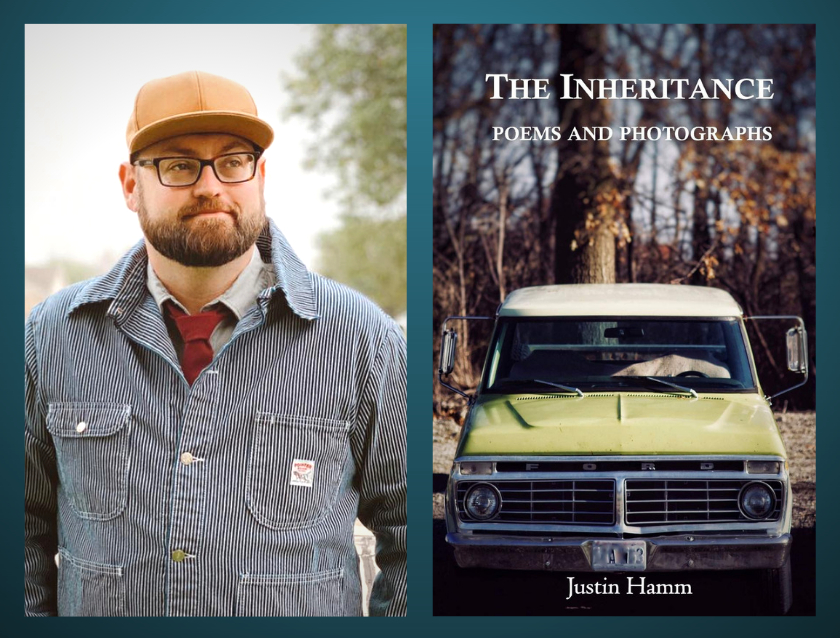 Justin Hamm is a Mid-Missouri author whose latest book is “The Inheritance.” It’s a book of poetry and photographs that focus on various aspects of the Midwest. He’s published two other collections of poetry, “American Ephemeral,” and “Lessons in Ruin,” as well as a book of photographs titled “Midwestern.” Last year he also released a spoken word album featuring his poetry, “Federico Garcia Lorca Blues.” Originally from the flatlands of central Illinois, Hamm now lives in Mid-Missouri with his family and I emailed some interview questions to him, and he was kind enough to take time to write back some answers.
Justin Hamm is a Mid-Missouri author whose latest book is “The Inheritance.” It’s a book of poetry and photographs that focus on various aspects of the Midwest. He’s published two other collections of poetry, “American Ephemeral,” and “Lessons in Ruin,” as well as a book of photographs titled “Midwestern.” Last year he also released a spoken word album featuring his poetry, “Federico Garcia Lorca Blues.” Originally from the flatlands of central Illinois, Hamm now lives in Mid-Missouri with his family and I emailed some interview questions to him, and he was kind enough to take time to write back some answers.
Daniel Boone Regional Library: What draws you to write poetry about many different areas in the Midwest instead of just one region or state?
Justin Hamm: I travel quite a bit, and have connections in a number of different Midwestern states. So, while I’m from Illinois and Missouri, I’m always taking in aspects of these other places, too, shooting pictures and learning about their history. Minnesota, South Dakota, Colorado, Kansas, Iowa, Oklahoma. They all have poem-worthy features and those features tend to stand out as a visitor.
DBRL: You started out using your photos to inspire and accompany your poetry, but at some point the photos became “an artistic pursuit in its own right.” How & why did your relationship to photography change?
Hamm: Poetry can be tough work. Not roofing-a-house-in-a-hundred-degrees tough. But emotionally, you have to clock in and go to work in some hard places in order to write poems to comfort and challenge and move readers. Personal places I’m not strong enough to visit every day. Photography gave me an outlet for my creativity during times I wasn’t up to meeting the page with the necessary vulnerability. I hope there is still emotion in my photographs, of course, and I think there is, but the photos aren’t so explicitly personal. The viewer gets to supply a greater proportion of the personal aspect than in poems.
That realization was one major change. The other happened when galleries and spaces began to feature the photographs. Naturally, when you learn there are steady homes and audiences for your work, however modest, it adds a level of seriousness and care.
DBRL: Last year you took some of your poems (old and new, published and unpublished) and turned them into a spoken word album. What was that process like?
Hamm: It was really a great experience. Obviously not much was happening during the pandemic, and I didn’t have a ton of new poems, so I decided to try to capture some of the poems I thought I’d learned to read fairly well over the years. But I wanted it to expand on what happens at a typical reading.
My friend, Dave Reetz, who runs Mexico Music in Mexico, MO is a great musician and sound guy. So I’d go in and record a reading and then he and I would talk about what sound and style would make sense for that poem. Spanish guitar on “Goodbye, Sancho Panza.” Dignified piano on “Gratitude for the Poets.” He has some nice technology with pre-recorded loops, and in cases where we couldn’t find what we were looking for there, he would play and record the parts himself. We’d talk about reverb and where sounds appeared in the mix, and he’d go back and play around with it again until we thought it worked.
DBRL: Read anything good lately you’d like to recommend?
Hamm: The poet Frank Stanford’s book “What About This” is in the DBRL system. He was a gritty Ozark poet, and his poems are wild and dark and hard to put down. Nikky Finney’s “Love Child’s Hotbed of Occasional Poetry” (available through the DBRL) is quite powerful and Sean Thomas Daugherty’s “The Second O of Sorrow” (available as an ebook in the DBRL system) is another great poetry book.
DBRL: Where can readers get a copy of your books?
Hamm: They’re on Amazon, but you can bypass the big business by ordering from me directly at justinhamm.net/books. Just click on the book you’d like to purchase and there will be a “buy now” option.


